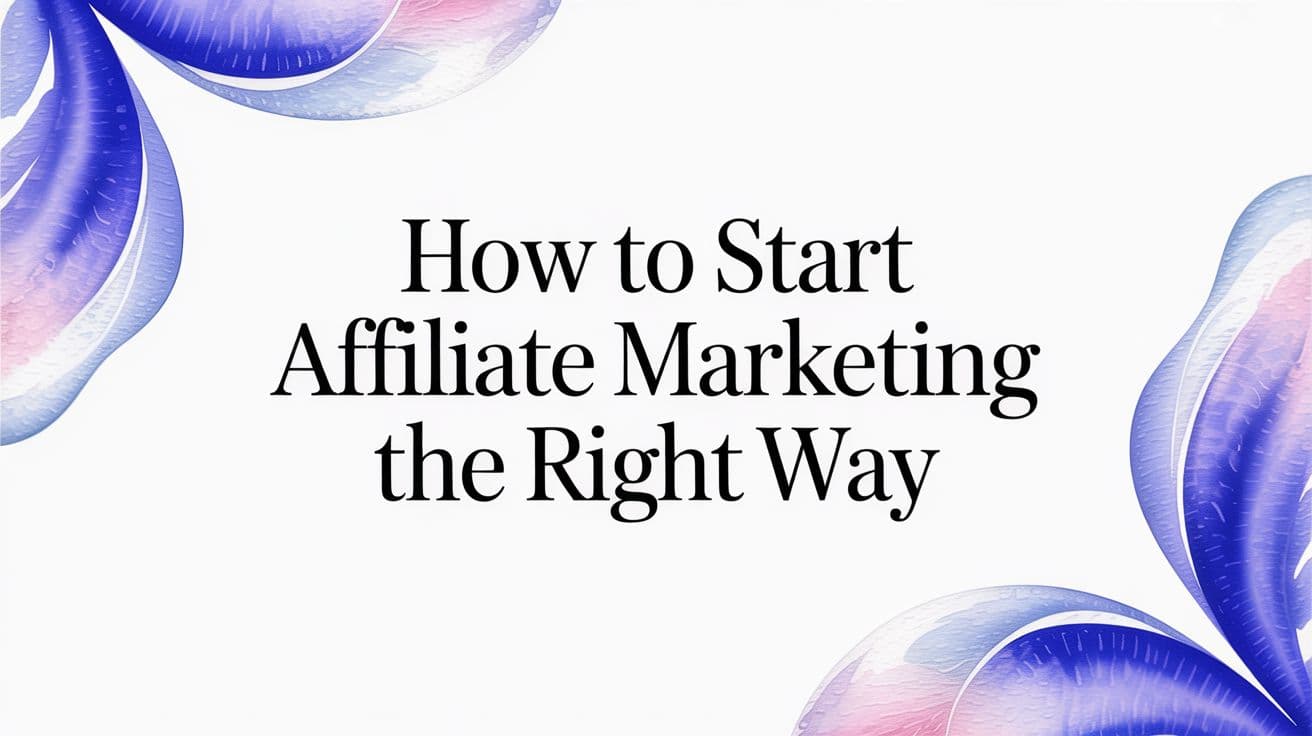How to Start Affiliate Marketing The Right Way
How to Start Affiliate Marketing The Right Way
Ollie Efez
October 24, 2025•20 min read

So you want to get started with affiliate marketing? The core idea is simpler than you might think. It really boils down to choosing a topic you're passionate about, gathering an audience that trusts your opinion, and then pointing them toward products that will genuinely make their lives better. Forget secret formulas or get-rich-quick hacks. This is about building real value first, and the commissions will follow.
Understanding How Affiliate Marketing Actually Works

Before you jump in, let's get one thing straight. At its heart, sustainable affiliate marketing is all about trust. It's a three-way relationship between you (the affiliate), your audience, and the brands you recommend. You’re not a salesperson; you’re a trusted guide. Your job is to help people solve a problem or reach a goal by suggesting the right tool for the job.
Here’s how the magic happens: someone clicks your unique affiliate link and buys something. The brand then pays you a cut of the sale. It’s a classic win-win-win.
- The customer gets a solution they can trust.
- The brand gets a new customer without a massive ad spend.
- You earn a commission for connecting the dots.
This model is so powerful that the affiliate marketing industry is on track to hit a global valuation of around $31.7 billion by 2031. A huge reason for this is that 81% of brands have caught on and now use affiliate programs to grow. It just works.
The Four Pillars of Affiliate Marketing Success
To build something that lasts, you need to focus on four core principles. Think of them as the legs of a table—if one is wobbly, the whole thing can come crashing down. These are the non-negotiables.
Mastering these four pillars isn't just a good idea; it's the only way to build a reliable, long-term income stream in this space.From Day One to Your First Commission
Let's make this real. Imagine you're a coffee nerd who's obsessed with home espresso. You start a blog reviewing beginner-friendly espresso machines. Your posts are full of practical tips that help newbies avoid common pitfalls, and you start building a small but loyal following.
Then, you write a deep-dive review of a machine you absolutely love, and you include your affiliate link. A reader, who has come to trust your honest assessments, clicks that link and makes a purchase. Boom—that’s your first commission. See? You didn't sell them anything. You helped them make a great decision.
This is the mental map you need: Solve problems first, sell second. When your primary goal shifts from earning a commission to helping your audience, the commissions will follow as a byproduct of the value you create.
This approach doesn't just feel better; it's also your best defense against the shadier side of the industry. Unfortunately, there are plenty of bad actors out there. To protect yourself and your audience, it’s smart to learn how to spot and steer clear of common affiliate marketing scams. Keeping this "help first" mindset will guide every decision you make, from the niche you pick to the products you stand behind.
How to Find a Niche You Genuinely Enjoy

Let’s talk about the single biggest mistake I see new affiliate marketers make: they chase profitable niches they couldn't care less about. This is a fast track to burnout.
When you're genuinely into a topic, creating content stops feeling like a chore. It becomes sharing something you love. That authentic enthusiasm is magnetic—it's what builds the trust you absolutely need to succeed in this game.
So, flip the script. Don't start by asking, "What makes money?" Instead, ask yourself, "What could I talk about for hours and not get bored?" That's your secret weapon. You can't fake authenticity, and it’s the one thing that will set you apart from the sea of generic, soulless affiliate sites.
Your mission is to find that sweet spot where your interests, your knowledge, and what people are looking for all overlap. It's the difference between forcing yourself to write about crypto trends and eagerly sharing your quest for the perfect home espresso machine.
Brainstorming Your Potential Niches
Alright, time to get practical. Grab a notebook or open a blank document and just start listing things that interest you. Don't overthink it or worry about profitability yet. Just get it all down.
Need a little push? Try answering these questions:
- What are your hobbies? Think hiking, video games, home brewing, gardening—anything you do for fun.
- What problems have you solved for yourself lately? Maybe you found the best ergonomic chair for your home office or figured out a new piece of software.
- What do your friends and family ask you for advice about? Are you the go-to person for travel tips, tech recommendations, or fitness routines?
- What do you read about or watch in your free time? This could be anything from personal finance and sustainable living to classic car restoration.
Once you have a decent list, you'll start seeing some patterns. A general interest in "video gaming" could become something more specific like "ergonomic gear for gamers," "budget PC builds," or "indie game reviews." A love for "gardening" might lead you to "urban container gardening" or "organic pest control."
The key is to get specific. A broad niche like "fitness" is a battlefield. But a focused niche like "postpartum fitness for busy moms" solves a specific problem for a specific audience you can genuinely connect with and help.
Validating Your Niche Idea
Now that you've got a few solid ideas, it's time for a quick reality check to see if they have commercial legs. You don't need a PhD in market research, just a few simple checks to make sure people are actually spending money here.
A good place to start is looking at the bigger picture. We know that, on average, brands using affiliate marketing see an impressive ROI of $15 for every $1 spent. And while popular niches like education, travel, and beauty are always strong, blogs are still a preferred channel for 27.8% of brands. That tells you there’s plenty of commercial intent out there. If you want to dive deeper, you can explore affiliate marketing statistics and trends for a full breakdown.
This quick look helps confirm that your passion project could actually become a profitable business.
Quick Research Techniques
Here are three dead-simple ways to test your niche's viability without getting bogged down in analysis paralysis:
- Search for Affiliate Programs: Just pop "[Your Niche] + affiliate program" into Google. If big-name brands and retailers show up with programs, that's a huge green flag. A search for "home espresso machine affiliate program," for instance, will bring up programs from Breville, Seattle Coffee Gear, and of course, Amazon.
- Check the Search Buzz: Use a free tool like Google Trends or a free keyword tool. You're looking for steady, consistent interest, not necessarily a massive viral spike. A stable interest level is far more valuable in the long run.
- Scope Out the Competition: See what other blogs, YouTube channels, or social media accounts are doing in your space. Are they actively promoting products? Don't be discouraged if you see other affiliates—it's actually a great sign! It proves the market is healthy. Your unique voice and perspective are what will make you stand out.
By pairing your genuine passion with this simple validation process, you’re building a rock-solid foundation for your journey into how to start affiliate marketing. You'll have a niche you're actually excited to build, and that’s the most critical ingredient for long-term success.
Choosing Your Platform and Creating Content That Connects

Alright, you've landed on a niche that actually gets you excited. Now comes the next big question: where are you going to build your audience? This isn't just about picking a website builder or a social handle; it’s about choosing the stage where your personality can truly shine.
Your main options boil down to a blog, a YouTube channel, or a social media profile. Each one has a totally different vibe.
If you’re a natural writer who loves digging into the details, a blog is a fantastic asset that you own and control completely. But if you’re more of a visual person who’s comfortable on camera, YouTube is an absolute beast. And if you’re great at quick, punchy content and love back-and-forth conversations, a platform like Instagram or TikTok might be the perfect fit. Don't just pick what's popular—pick what feels right for you.
The Content-First Mindset
No matter where you decide to set up shop, your success boils down to one simple idea: a content-first mindset. This means your number one job is to help people. Solve their problems, answer their questions, and offer real value—long before you ever ask for a sale.
People are smart. They can smell a sales pitch a mile away and are tired of being constantly sold to. Your content is what builds the bridge of trust.
When someone stumbles upon your article or video and it genuinely helps them solve a problem, they start to see you as an authority. That trust is everything in affiliate marketing.
The best affiliate promotions never feel like promotions. They feel like a helpful recommendation from a friend who’s been there. That’s the goal.
When you get this right, your affiliate links stop being ads and start being helpful resources. You’re not just dropping a link; you’re pointing them to a solution you’ve already checked out for them. It’s a small shift in thinking that makes a huge difference.
Practical Strategies for Content That Connects
So, how do you actually create this kind of content? It’s not about some secret formula. It's about being honest, helpful, and transparent.
Here are a few types of content that just plain work for affiliates, regardless of the platform:
- In-Depth Product Reviews: I'm not talking about just listing the features. Get personal. Share what you loved, what you didn't, and who it's actually for. A review that points out a product's small flaws is infinitely more believable than one that’s all sunshine and rainbows.
- Detailed 'How-To' Tutorials: Show people how to do something. A video walking someone through setting up a new piece of software or a detailed blog post with pictures on how to use a specific kitchen gadget provides massive value.
- Honest Comparison Posts: People are always stuck between choices. Be the one to help them decide. A "Product A vs. Product B" post can become the go-to resource for anyone on the fence. Plus, you can include affiliate links for both options.
The key to all of this is utility. Make your content so useful that people feel compelled to follow your advice. The commissions will follow. If you're still weighing your options, our guide on the best affiliate marketing platforms dives deeper into the pros and cons of each.
A Real-World Example
Let's say your niche is ergonomic home office setups. You could create a YouTube video called, "5 Desk Chair Mistakes That Are Killing Your Back."
In the video, you don't just push a chair. You educate. You show people what bad posture looks like and explain why proper lumbar support and armrest height matter.
As you explain these points, you can use your own chair as an example, pointing out why its specific features help you avoid those exact mistakes. Then, at the end, you can say something natural like, "By the way, if you want to check out the chair I've been using for the past year, I'll drop a link to it in the description."
This works because you gave them real value first. The link isn't a random ad; it's the solution to a problem you just helped them understand. This is how you build a loyal audience that trusts your recommendations, which is the whole game when you're figuring out how to start affiliate marketing.
Finding Affiliate Programs That Actually Fit Your Brand
Alright, you’ve picked a niche you’re genuinely excited about and have a platform ready to go. Now comes the fun part: finding products and services to promote. This is a crucial step, and honestly, it’s where a lot of beginners trip up. They get lured in by high commission rates and forget to ask the most important question: "Does this actually make sense for my audience?"
Choosing the right affiliate programs is about so much more than the payout. It’s about maintaining the trust you're working so hard to build. If you promote a shoddy or irrelevant product, you can burn that trust in an instant. Think of yourself as a trusted curator for your audience, only recommending things that will genuinely make their lives better.
Affiliate Networks vs. Direct Programs
As you start your search, you'll notice two main paths you can take: joining massive affiliate networks or partnering directly with brands. Knowing the difference will help you build a smarter, more profitable strategy.
- Affiliate Networks: These are the big marketplaces like ShareASale, CJ Affiliate, or Amazon Associates. They're basically a middleman, giving you access to thousands of brands all under one roof.
- The upside? You can find tons of programs, manage everything from a single dashboard, and get one consolidated payment.
- The downside? Commissions can be lower, you don't have a direct relationship with the brand, and you're competing with a lot of other affiliates.
- Direct-to-Brand Programs: Many companies, especially in the SaaS and e-commerce space, run their own affiliate programs. You apply right on their website and often work directly with their team.
- The upside? Commissions are often much higher, you get a direct contact (an affiliate manager), and you might get access to exclusive deals for your audience.
- The downside? You have to find and apply to each one individually, which means juggling multiple logins and separate payouts.
In my experience, a hybrid approach is the way to go. You could use Amazon for a wide range of physical products while also building direct partnerships with a few key software companies that are essential to your niche.
A Quick Checklist for Vetting Programs
Not all affiliate programs are created equal—not by a long shot. Before you hit that "sign up" button, take a few minutes to vet every potential partner. Rushing this is a classic mistake when you're just learning how to start affiliate marketing.
Here’s what I always look for:
- Product Quality & Relevance: This is the big one. Would you personally use this product? Would you recommend it to a close friend? If the answer is anything but a resounding "yes," walk away. It doesn't matter how high the commission is.
- Commission Rate: What’s in it for you? The rates vary dramatically, from 1% on some physical goods to 50% or more on digital products like courses or software. Make sure the payout is actually worth the time and effort you’ll invest.
- Cookie Duration: How long after someone clicks your link do you get credit for a sale? This is the "cookie window." A longer duration—like 30, 60, or even 90 days—is always better than a short one, like Amazon's 24 hours.
- Payout Reliability: Do they actually pay on time? A quick search for reviews from other affiliates can tell you a lot. Consistent, reliable payouts are non-negotiable.
Your integrity is your most valuable asset. Your long-term success hinges on your audience trusting you. Sacrificing that trust for a quick buck is the fastest way to kill your affiliate marketing career before it even starts.
Why Authentic Promotion is Winning
The world of affiliate marketing is always changing. Today, authentic, personal recommendations are everything. Just look at the influencer marketing space, which is expected to jump from $24 billion in 2024 to $32.55 billion in 2025.
This growth is fueled by trust. A staggering 69% of consumers trust recommendations from influencers more than they trust a direct ad from a brand. As an affiliate, this trend works directly in your favor. If you want to dig deeper, this article about what's next for affiliate marketing on sticky.io has some great insights. It all comes down to this: your personal story and your honest experience with a product are your most powerful marketing tools.
How to Get Traffic to Your Affiliate Content

Creating amazing content is a huge win, but it’s only half the battle. If nobody sees your brilliant product reviews or helpful tutorials, you won't make a single commission. Now that you've got the content, the next part of your journey is getting eyeballs on your work.
The good news? You don't need a massive advertising budget to make an impact. By focusing on a few sustainable, long-term strategies, you can build a steady stream of visitors who are genuinely interested in what you have to say.
Taming the SEO Beast
Search Engine Optimization (SEO) sounds way more intimidating than it is. At its core, SEO is just about helping Google understand what your content is about so it can show it to the right people. It's easily the most powerful way to get consistent, free traffic over time.
Think of it like this: when someone types "best hiking boots for beginners" into Google, they have a problem they need to solve. Your job is to create an article that is the absolute best answer to that question.
To get there, you first need to understand keywords. These are simply the phrases people are actually typing into search engines. You can start with free tools like Google Keyword Planner or get more advanced with paid options like Ahrefs to find out what your audience is looking for.
Once you know the right keywords, you just need to weave them naturally into your content:
- In your main title (H1)
- In a few subheadings (H2s and H3s)
- Somewhere in the first paragraph
- A couple of times throughout the rest of your text
The trick is to keep it feeling natural. Don't just stuff keywords where they don't belong. Always write for a human first and the search engines second.
Using Social Media and Online Communities
While SEO is a long-term game, social media and online communities can bring in traffic right now. The secret is to show up where your target audience already hangs out and be genuinely helpful, not spammy.
For instance, if your niche is home espresso, you could join a subreddit like r/espresso or a few dedicated Facebook groups. Instead of immediately dropping links to your blog, start by answering questions and sharing your own experiences.
People in these communities can spot a self-promoter from a mile away. The goal is to become a trusted, helpful member of the group first. Once you've built that reputation, people will naturally become curious about what you do.
When the time is right, you can share a link to a relevant blog post you wrote that solves a specific problem someone is having. This approach builds your authority and drives highly engaged traffic back to your site.
Build an Email List From Day One
I can't stress this enough: an email list is one of the most valuable assets you can build. Unlike social media followers or search rankings, your email list is something you own and control completely.
Start by offering something valuable in exchange for an email address. This could be a simple checklist, a short e-book, or a free email course that’s relevant to your niche.
Once someone subscribes, you can send them weekly or bi-weekly newsletters with your best content, personal stories, and exclusive tips. This builds a much deeper relationship and gives you a way to drive traffic to new content whenever you want.
The Power of a Dedicated Landing Page
As you start promoting different products, creating a dedicated landing page for affiliate marketing can seriously boost your conversions. Instead of sending traffic directly to a merchant's website, you send them to a page that you control first.
This page can be designed to highlight the product's benefits, include your personal review, and feature a strong call-to-action. Our guide on building a high-converting landing page for affiliate marketing walks you through the entire process. This one step gives you far more control over the user experience and can lead to a lot more sales.
The growth in affiliate marketing is undeniable. In the United States alone, spending is projected to climb from $9.56 billion in 2023 to nearly $12 billion by 2025. This momentum shows a massive opportunity for new affiliates who are willing to put in the work.
By combining a smart SEO strategy, active participation in online communities, and a dedicated email list, you create a powerful system for driving consistent traffic. This diversified approach ensures your affiliate marketing business is built on a stable foundation for the long haul.
Your Affiliate Marketing Questions, Answered
Jumping into affiliate marketing brings up a ton of questions. It's totally normal to feel a bit overwhelmed at first, so I've put together some straight-to-the-point answers for the things beginners ask most often.
Getting a handle on these basics will give you the confidence you need to really get started.
How Much Does It Cost to Start Affiliate Marketing?
This is one of the best parts—you can genuinely get started with almost no money.
If you're planning to use social media like Instagram, YouTube, or TikTok, your startup cost is basically zero. The real investment is your time and creativity in making content that people actually want to see.
If you decide a blog is more your style, you're only looking at a couple of small costs:
- Domain Name: Usually runs about $10-$15 a year.
- Web Hosting: You can get solid hosting plans for as little as $3-$5 a month.
And that's pretty much it. You don't need inventory, a storefront, or a huge pile of cash. This low-cost entry makes it a great option for just about anyone curious about how to start affiliate marketing.
How Long Does It Take to Make Money?
Ah, the million-dollar question. The honest answer? It depends. Be wary of anyone promising you'll be rich overnight—that's just not how this works. Building a real, sustainable income with affiliate marketing is a marathon, not a sprint.
A realistic timeframe to start seeing some consistent money coming in is anywhere from 6 to 12 months. This all hangs on your niche, the quality of your content, and your ability to get it in front of the right people. Those first few months are all about building trust and proving you know what you're talking about, which lays the foundation for everything else.
Key takeaway: Focus on giving your audience massive value first. When you genuinely help people solve a problem, the money follows as a natural result of the trust you've built.
Do I Need a Huge Following to Be Successful?
Nope, not at all. This is one of the biggest myths out there. The quality of your audience matters so much more than the quantity.
So-called "micro-influencers," who have smaller but super-engaged followings, often get way better results. A loyal community of 1,000 people who trust what you say is a thousand times more valuable than 100,000 followers who scroll right past your posts. Forget the vanity metrics and focus on building real connections.
Can I Do Affiliate Marketing Without a Website?
Absolutely. While having a website is a great long-term asset, it's definitely not a requirement to get started or even to be incredibly successful.
Plenty of affiliates build their entire business on a single platform. For example:
- A YouTube channel with helpful product reviews and tutorials.
- An Instagram or TikTok account perfect for visual niches like fashion or travel.
- A focused email newsletter where you share exclusive deals and tips.
The trick is to pick one place, show up consistently, and build a community around your topic. That's where the magic happens.
Ready to take control of your affiliate partnerships? LinkJolt provides a powerful, all-in-one platform to create, manage, and scale your affiliate program with ease. Start your journey today at https://linkjolt.io.
Watch Demo (2 min)
Trusted by 100+ SaaS companies
Start Your Affiliate Program Today
Get 30% off your first 3 months with code LINKJOLT30
✓ 3-day free trial
✓ Cancel anytime